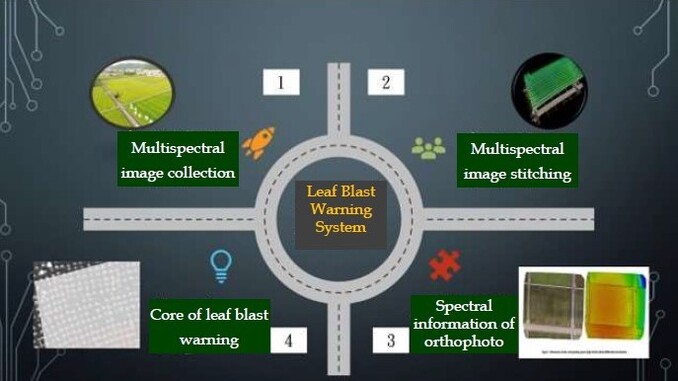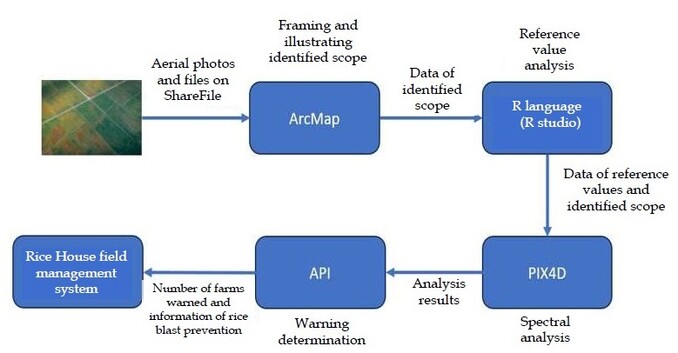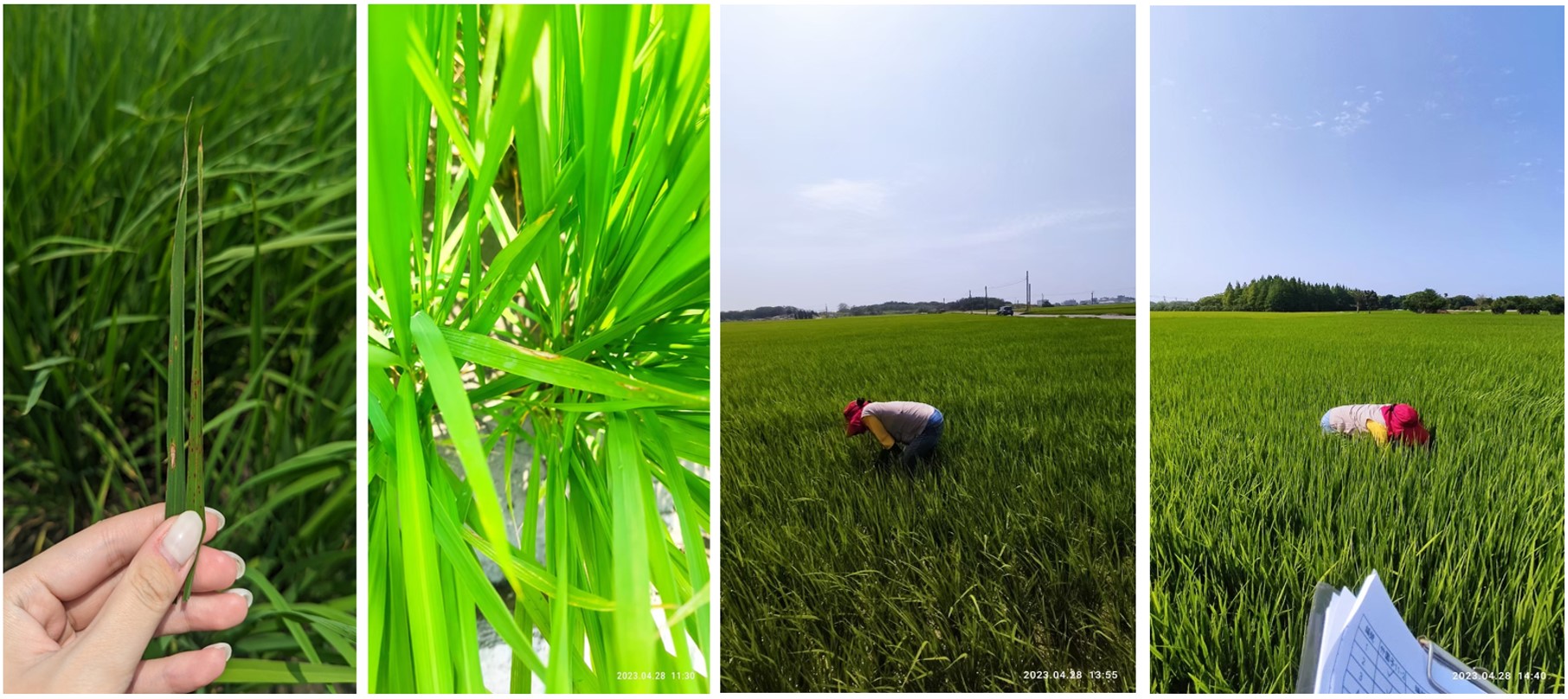Author:Lai Ming-Hsin /Researcher at the Taiwan Agricultural Research Institute
Rice blast is the most severe disease affecting rice production, an epidemic that occurs annually and reduces rice yield significantly. When the disease occurs on the leaves, it is referred to as leaf blast. If it occurs on the panicles, it is known as panicle blast. The occurrence of leaf blast significantly increases the amount of fungus in the field, thereby highly affecting the likelihood of panicle blast. Thus, the prevention of rice blast must start with preventing leaf blast. In the first phase of smart agriculture, we successfully developed the “Leaf Blast Warning Technology”, which could be used to identify the infection of rice plants resulted from the invasion of the rice blast fungus before the symptoms appear on the leaves, allowing for early prevention and treatment, thereby achieving the prevention of the disease. The technology, with an accuracy of over 80%, has been proven to be effective after field validations. Along with the prevention and treatment by using fungicides, it can indeed prevent the occurrence of rice blast successfully.
 Fig. 1 The connotation and operating process of the Leaf Blast Warning Technology
Fig. 1 The connotation and operating process of the Leaf Blast Warning TechnologyTo disseminate and spread this technology for it to be used by rice farmers, it is necessary to introduce the capacity of the private sector and emerge to a commercial service model to grasp the opportunity for widespread adoption. The rice production and OEM system in Taiwan is world-renowned. A phone call would be enough to enable rice production. Theoretically, introducing the capacity of the private sector should not be challenging. Unfortunately, the smart agriculture technology is not a mechanical tool, but a combination of information, software and hardware, which requires some background knowledge in artificial intelligence. Thus, the technology is not suitable for traditional rice OEM companies or cooperatives. Only information service providers and information integration or engineering companies have the capacity to adopt this technology. Furthermore, cooperation with drone operators and suppliers is required to provide the service. After promotion through the media, Knowledge and Service Information Corp. became the first authorized supplier of this technology. The company planned to introduce the new technology into the original agricultural service information platform to improve the service functionality and competitiveness of the information platform.
 Fig. 2 A structural diagram of the cloud system, from field image collection to warning the contract farmers
Fig. 2 A structural diagram of the cloud system, from field image collection to warning the contract farmersThe purpose of licensing this technology is to enhance the capacity for its dissemination. Thus, after the technology is licensed, in addition to transferring the entire software technology to the supplier, the supplier is also trained in service capabilities. It is also necessary to implement education and training for rice farmers to understand and accept the results of this technology. Further, the operators are assisted in reducing the financial pressure they faced during the initial phase of providing this technology service, thereby enhancing the motivation of the operators to proceed. As an ecosystem facilitator, we guide the licensed manufacturer to apply for the Smart Agriculture Diffusion Project of the Ministry of Agriculture to seek fund investment. With the authorized supplier, Knowledge and Service Information Corp., serving as the cornerstone and with the goal of spreading and using the licensed technology, we looked for operators concerned about the spreading and use of the technology to propose the 2023 diffusion project. The incorporated partners included the information service provider Ling Cheng Technology Co., Ltd., the agricultural service provider Digital Agriculture Technology Ltd., and the equipment service provider Taiwan Futaba Electronics Corporation, with the Big Bridge Specialized Rice Production and Marketing Area being the field for spreading and demonstrating the technology. The proposal was titled “Application Demonstration and Promotion Plan of Introducing Smart Planting Technology into the Rice Farming Industry”. Initially, Knowledge and Service Information Corp. acted as the contact and developed the project implementation framework and outline. Representatives of the participating partners and companies were also gathered for a meeting. Knowledge and Service Information Corp. presented the idea of the proposed project and set up tasks to be carried out by each partner for discussion. The participating partners confirmed the connotation, budget, and adjustments of the tasks to be carried out. Then, the tasks and their content were drafted according to the developed direction while presentations were prepared. All data drafted and prepared was sent to Knowledge and Service Information Corp., the person in charge from which organized and drafted the project plan as well as measuring and selecting the data required while making adjustment accordingly. When the draft project plan was completed, it was sent to the participating companies for review, followed by an online meeting for presentation, discussion and confirmation of the content of the project plan. After ensuring the accuracy, the application process for the project was performed. Knowledge and Service Information Corp. was responsible for dealing with any subsequent supplementary data of the plan, responses, and presentations for project review as the participating partners provided supports and cooperated in attending meetings. The successful application for the subsidy for the 2023 Smart Agriculture Diffusion Project seemed to provide a significant boost for the application and dissemination of the smart agriculture technology “Leaf Blast Warning Technology”.
However, the participating partners have their own distinct corporate cultures and diverse ideas about the implementation of the content of the project despite the thorough communication before the proposal of the project. With project implementation on the horizon, these problems must be overcome. Therefore, a kick-off meeting was convened before the project was implemented. Knowledge and Service Information Corp. reported on further details of project implementation and confirmed the tasks to be performed, time of surveys, content of collaborative work, monitoring and evaluation schedule, budget evaluation, problem reporting, etc. The participating partners went into detailed discussions and made mutual coordination and arrangements. Confidence in project implementation was only built after this meeting. Genuine communication among the participating partners was only facilitated since, ensuring that the work performed by each partner reflects considerations of the collective effort, thereby moving beyond a silo mindset and embracing a sense of being a community of shared life. During the project implementation period, not only periodical online meetings and midterm review meetings were held for all partners; more two-party or three-party in-person and online meetings were also convened. The meetings did not necessarily take time, mainly involving discussions on stages of implementation and problem-solving. The most frequent form of communication was Line group discussions and coordination, which fostered teamwork and ensured that every partner was able to perform the tasks as planned and scheduled.
Regarding the details of spreading and implementing the technology, in terms of the farmer end, the smart agriculture technology “Leaf Blast Warning Technology” was an entirely new tool for the contract farmers in the demonstration field. The effectiveness of the technology was completely unknown to the farmers; however, the effectiveness of disease prevention directly impacted their income, which made the participating farmers anxious. Though the contract grain supplier (Rice House Smart Agri Co., Ltd.) from the Specialized Rice Production and Marketing Area had been comforting and providing guarantees to the farmers, the farmers did not trust the new technology enough as they lacked experience in it, and there was no legacy of knowledge transfer from previous users. Hence, the farmers easily doubted the technology, resulting in poor cooperation and twice the effort to achieve the effectiveness of the technology’s dissemination. To avoid the above-mentioned problems and build the farmers’ trust in the technology, Rice House Smart Agri Co., Ltd., one of the partners, borrowed a venue through coordination to gather the contract farmers for an orientation. The technology licensing unit (Taiwan Agricultural Research Institute) among the partners dispatched experts to present and explain the content of the technology and the adoption of cultivation management to the farmers. The meeting was lively with discussions. Though experienced, old farmers were doubtful about the usability of the technology and questioned the correctness of its results repeatedly, it was encouraging to see that large farmers and younger farmers showed great interest and a willingness to try for the technology. They agreed on the idea that field management tools and concepts need to improve with time.
The next step would be the transfer of the smart agriculture technology. Knowledge and Service Information Corp., one of the partners, was a medium-sized information service company with over 70 employees. In the past, the company provided services to industry and commerce or facility operators, making the company extremely unfamiliar with agricultural services related to outdoor plants and lack of related hardware equipment. The Taiwan Agricultural Research Institute licensed the transfer of the software with respect to the “Leaf Blast Warning Technology” and conducted educational training for the programmers of Knowledge and Service Information Corp. More importantly, simulation drills in the fields were carried out. Accompanied by researchers from the Taiwan Agricultural Research Institute, the personnel from Knowledge and Service Information Corp. were guided through the processes of field image and data collection, data cleaning, image stitching and extraction, and image analysis step by step. Every step was carefully confirmed, allowing the personnel from Knowledge and Service Information Corp. to master and operate the technology in the shortest possible time. At the same time, the Taiwan Agricultural Research Institute provided explanations on the requirements for drone flights performed for the smart agriculture technology to Digital Agriculture Technology Ltd. to regulate the time and number of flight as well as image processing after flight. Furthermore, coordination was made for the data connection between Knowledge and Service Information Corp. and Digital Agriculture Technology Ltd. as well as the tasks involving Knowledge and Service Information Corp. and Ling Cheng Technology Co., Ltd. (e.g., disseminating the monitoring results to farmers). This ensured seamless implementation of business among partners and prevented any disruptions.
The dissemination and application of the “Leaf Blast Warning Technology” marks both a starting point and a turning point for the spreading and implementation of smart agriculture technology for rice cultivation. The starting point refers to looking for functional partners based on a single technology service and forming a team for coordinated operation, further proposing the project. The partners developed mutual understanding and negotiated for project implementation, sharing both the glory and challenges. Thus, an embryonic ecosystem was born. Through project implementation, a service model concerning smart agriculture technology will be created, facilitating the birth of the agricultural service industry. Rice disease management will be digitalized, leading to labor saving, high speed, and interpretation in the daily life in the future. As a result, the agricultural environment will be changed and transformed.
 Fig. 3 Confirmation of the identification result of the Leaf Blast Warning Technology through field investigation by experts, with an accuracy of up to 80%
Fig. 3 Confirmation of the identification result of the Leaf Blast Warning Technology through field investigation by experts, with an accuracy of up to 80%